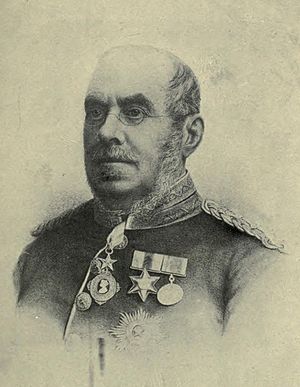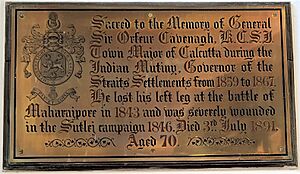Orfeur Cavenagh facts for kids
Quick facts for kids
Sir Orfeur Cavenagh
|
|
|---|---|
 |
|
| 7th Governor of Straits Settlements | |
| In office 6 August 1859 – 16 March 1867 |
|
| Monarch | Queen Victoria |
| Preceded by | Edmund Augustus Blundell |
| Succeeded by | Sir Harry St. George Ord |
| Personal details | |
| Born | 8 October 1820 Hythe, Kent |
| Died | 3 July 1891 (aged 70) St. Aubyn, Sussex |
| Spouse |
Elizabeth Marshall Moriarty
(m. 1842–1891) |
| Children | 2 sons |
| Parents |
|
| Profession | Colonial administrator, British Army officer |
| Awards | Knight Commander of the Order of the Star of India |
| Military service | |
| Allegiance | |
| Branch/service | |
| Rank | General |
| Battles/wars | Gwalior campaign First Anglo-Sikh War Indian Rebellion |

Sir Orfeur Cavenagh (born October 8, 1820 – died July 3, 1891) was a British Army officer who became a General. He is best known for being the last Governor of the Straits Settlements appointed by the government in India. He served as governor from 1859 to 1867.
Contents
Early Life and Military Training
Orfeur Cavenagh was the third son of James Gordon Cavenagh and Ann Coates. He was born in Hythe, Kent, England.
Cavenagh trained to be a soldier at Addiscombe Military Seminary. This was a special military school run by the East India Company. The East India Company was a powerful British trading company. It also ruled large parts of India.
He passed his exams in June 1837. In early 1838, he joined the 32nd Regiment Native Infantry. This was a part of the British Indian Army.
Early Military Roles
In 1840, Cavenagh passed another important exam in Fort William College in Calcutta. He was then made an interpreter and quartermaster for the 41st Regiment Native Infantry. An interpreter helps people speak different languages. A quartermaster is in charge of supplies for the army.
From 1840 to 1841, he worked with a military group near the border of Nepal.
Battles and Injuries
Cavenagh was an adjutant for the 4th Irregular Cavalry. An adjutant helps a commanding officer. In December 1843, he was seriously hurt during the Battle of Maharajpore. A cannonball hit his leg, cutting it off above the ankle. His horse was also killed under him.
He was wounded again in January 1846 during the First Anglo-Sikh War. This time, a cannonball hit his left arm. After these injuries, he was given a different role. He became the Superintendent of the Mysore Princes and the former rulers of Sindh.
Role During the Indian Rebellion
In 1850, Cavenagh traveled to Britain and France. He was part of the Nepal Embassy. In 1854, he was made Town and Fort Major of Calcutta.
In this role, he was responsible for the safety of Fort William. This was during the time of the Indian Rebellion (also known as the Sepoy Mutiny). This was a major uprising against British rule in India. Cavenagh worked under the Governor-General of India, first the Marquess of Dalhousie and then Lord Canning.
Governor of the Straits Settlements
Because of his important work during the Indian Rebellion, Lord Canning offered Cavenagh a new job. He was asked to be the Governor of the Straits Settlements. He started this job on August 8, 1859.
What were the Straits Settlements?
The Straits Settlements were a group of British territories in Southeast Asia. They included Singapore, Malacca, Penang, and Dinding. These areas were combined in 1826. The Governor of the Settlements and his council reported to the Governor-General of India in Calcutta.
The Governor did not have much official power. However, he could influence the authorities in Calcutta. They often relied on his advice for new laws and policies.
End of His Term
Control of the Straits Settlements changed on April 1, 1867. It moved from Bengal (in India) to the Colonial Office in London. This meant the Settlements became a Crown colony. A Crown colony was directly ruled by the British government.
Cavenagh was the last Governor who reported to the Governor-General in Calcutta. His replacement, Sir Harry Ord, reported directly to the Colonial Office in London. Cavenagh's term as governor ended on March 16, 1867.
Later Military Career and Retirement
After his time as governor, Cavenagh continued his military career. He was a general officer in the Bengal Staff Corps. He was promoted to lieutenant general in September 1874. Then, he became a full General in August 1877.
Personal Life and Legacy
Cavenagh married Elizabeth Marshall Moriarty on September 7, 1842, in India. They had two sons.
In his retirement, he lived in Long Ditton, Surrey, England. In June 1884, he was made an honorary colonel of the 5th Surrey Volunteer Corps. He passed away on July 3, 1891. He was buried in the churchyard of St Mary's Church in Long Ditton. There is also a special plaque inside the church to remember him.
Honours and Recognition
Cavenagh received a high honour on May 24, 1881. He was made a Knight Commander of the Most Exalted Order of the Star of India (KCSI). This is a special award given for services to the British Empire in India.
Legacy
Two places in Singapore are named after Governor Cavenagh:
- Cavenagh Road
- Cavenagh Bridge
You can still see the coat of arms of the Cavenagh family on the signs at both ends of the Cavenagh Bridge.

